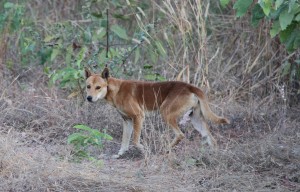The people from South Sulawesi in Indonesia probably introduced dingoes to Australia, according to research by Griffith University and the University of New England.
Professor Paul Tacon from Griffith University’s Place, Evolution and Rock Art Heritage Unitand archaeologist Dr Melanie Fillios from UNE looked at genetics and archaeology to find out the exact timing of the dingoes’ introduction.
“We’ve long known that people from South Sulawesi visited northern Australia for many hundreds of years but it now appears to have been several thousand. We now need to search for further evidence of this in both Sulawesi and north Australia,” Professor Tacon said.
“This study is significant because dogs were the first species to be domesticated by people with some saying this relationship happened as long ago as 35,000 years.”
Researchers looked at five different groups; Indian mariners, Lapita peoples, a Timor group, Taiwanese peoples and Toalean hunter-gatherer peoples from Sulawesi.
They found that Toalean or other hunter-gatherers from South Sulawesi in Indonesia were the likely suspects.
“We don’t know if the dingoes came through early agriculturalists, hunter-gatherers or sea-faring traders. But after looking at recent genetic studies of dingo origins we have managed to narrow down a list of potential groups who could have been responsible for their introduction,’’ Dr Fillios said.
The lack of starch digestion gene (AMY2B) in dingoes further supports the hypothesis that the dingo accompanied a hunter/gatherer people as opposed to people from an agricultural society.
A sophisticated maritime hunter-gatherer culture was widespread across the South Sulawesi area for over 40,000 years resulting in the initial colonisation of Australia.
No dog has yet been found in South Sulawesi archaeological sites, but the Toalean peoples were the strongest candidates for bringing the dingo to Australia, perhaps after obtaining it from people in Borneo.
“In Australia, dogs appear to be a relatively late arrival post-dating human settlement by at least 40,000 years. It is still a mystery as to who brought them here, why and when,’’ Dr Fillios said.
She said dogs accompanied people into all corners of the globe and this relationship can be used to understand the movement of people and ideas around Oceania during the Holocene.
“Not only were they the first animal to be domesticated by humans, this relationship predates the emergence of agriculture, making them a valuable key for human hunter-gatherer migrations.”
The research was published in the Journal of Archaeological Science: Reports this month.


